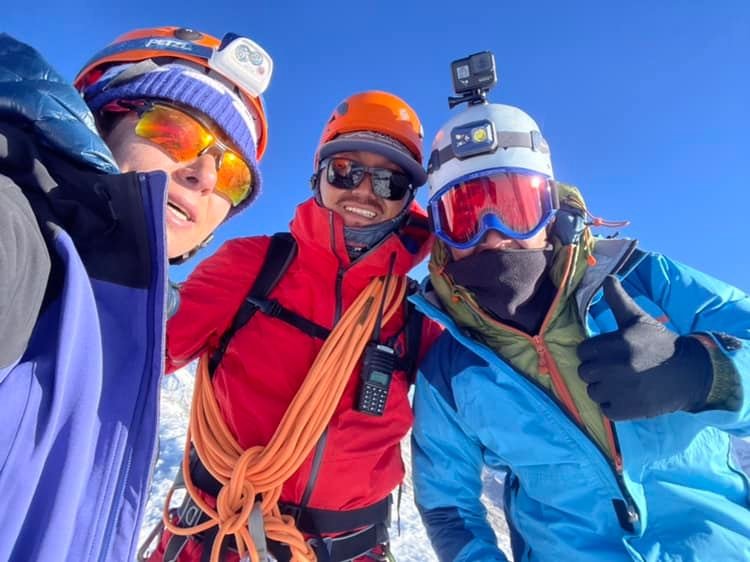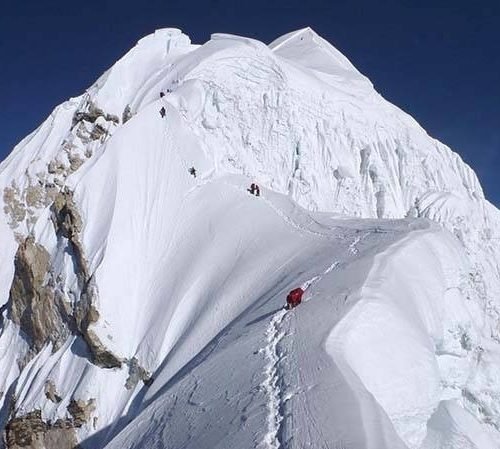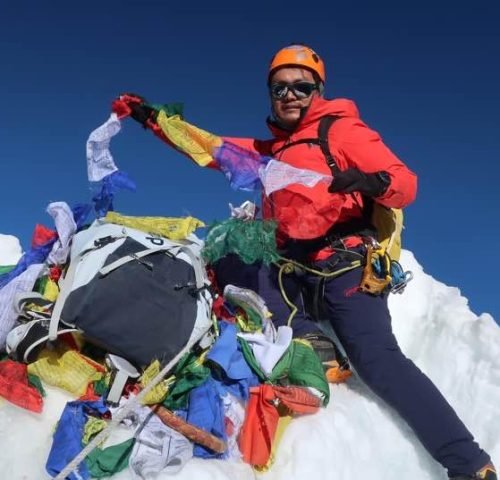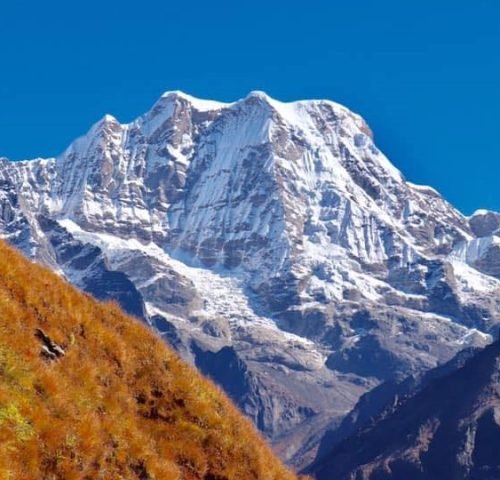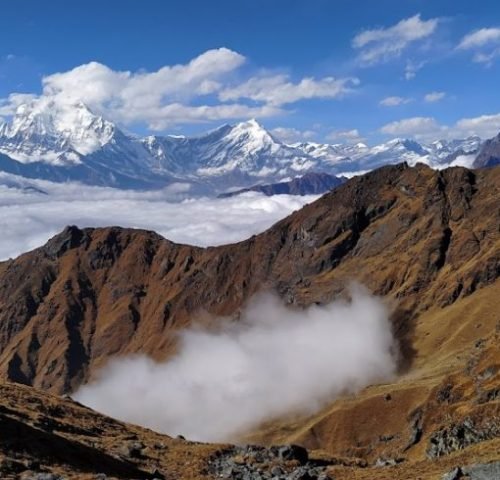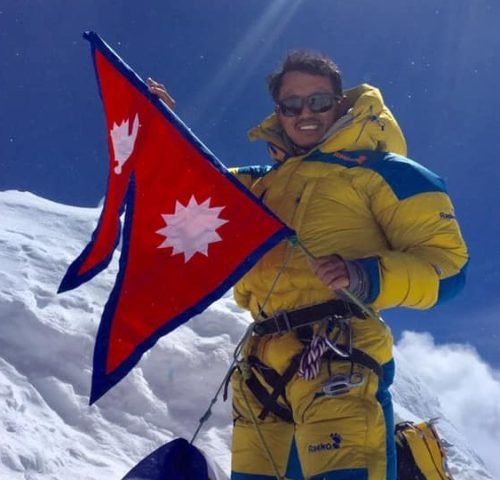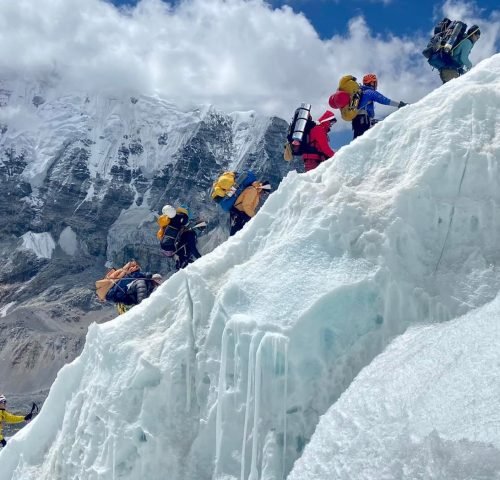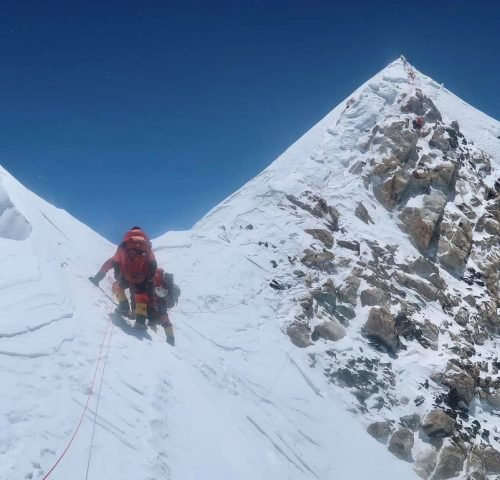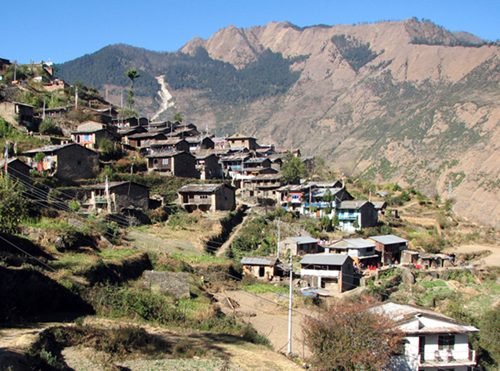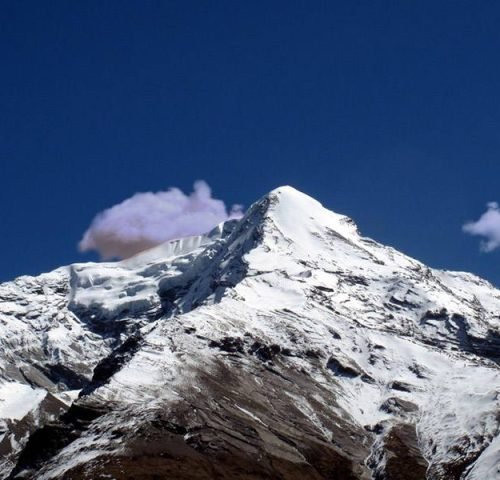Overview
Mt. Ama Dablam, known as the Matterhorn of the Himalaya, is one of the most recognized mountains in the world, a mountain that many aspiring mountaineers want to add to their logbook. Ama Dablam dominates the Imja valley and lies just a few kilometres south of Mt. Everest.
Embark on an extraordinary mountaineering expedition to conquer the majestic Ama Dablam, a jewel of the Himalayas. Standing tall at an impressive 6,812 meters, Ama Dablam beckons seasoned climbers seeking a formidable challenge and a chance to witness the breath-taking beauty of the Everest region. At Base Camp, under the watchful eyes of the climbing guides, you will settle into the expedition routine. There will be skills to revise, equipment to be checked and rotations on the mountain to aid acclimatization. When the weather is settled, and you are ready, you will begin your summit push which could take three or four days. The route normally incorporates 3 camps but sometimes, depending on the group and weather, the summit can be reached from Camp 2. The final push is likely to be a long day with the summit reached soon after dawn. Once the event has been duly recorded it will be time to carefully descend to a low camp for rest before continuing the descent to Base Camp.
Although Ama Dablam’s altitude may not match some of the highest peaks in the Himalayas, its technical difficulty and sheer beauty make it an arduous and rewarding climb. Only climbers with advanced mountaineering skills and extensive experience are invited to attempt this awe-inspiring peak.
Details Itinerary
DAY 01 :Arrive in Kathmandu.
Our office representatives will welcome you outside the terminal hall and transfer you to the hotel. Brief you about tomorrow’s activities and collect any documents required by our office.
DAY 02: Preparation & introduction (H,B, D)
On the second day, we will complete all of our formalities, such as getting the required paperwork, permits, and other formalities required for our expedition, and we will begin making preparations for it. We will now prepare our luggage, go shopping, and double-check everything we need (especially medicines and essentials). There will be briefings on every part of the expedition, including all gear and equipment, the length of the trip, lodging options, base camp facilities, and all other aspects related to the expedition. It also gives you the chance to interact with and get to know your climbing companions and colleagues.
DAY 03: Fly to Lukla (2800m). Trek to Phakding (2610m).
We take an early morning flight to Lukla, where all Everest treks begin. You will need permission from the locals to continue exploring once you arrive in Lukla. This is the entrance to the protected Khumbu Region. To proceed, you will need the Khumbu Pasang Lhamu Entry Permit. The Trekkers Information Management System card has been replaced with this admission permission. The admission fee goes toward the development of the rural community. Once you get into Lukla, eat breakfast at the lodge, and prepare luggage for the porters, the walking starts. To get to Phakding, there are a few ups and downs, as well as many prayer rocks (Mani in the local language). After you’ve settled into your Phakding lodge, take a short walk to the village.
DAY 04: Phakding to Namche Bazaar (3440m).
Our trail passes through a pine forest, and we continue our walk on the trail that goes north up the Benkar valley. We cross the Dudh Koshi River and pass Chumoa and Monjo villages before reaching the entrance of the Everest National Park. Then, after crossing a suspension bridge, we pass Jorsale village and walk alongside the Dudh Koshi and Bhote Koshi rivers. ascend on a steep trail and reach Namche Bazaar, which is probably the biggest town in the Everest region.
DAY 05: Rest Day in Namche Bazaar (3440m).
We can tour Namche Bazaar, which is the primary town of the Everest or Khumbu region. We can hike up to the Everest viewpoint hotel and enjoy the sunrise over the Himalayas, including Mt. Everest, Lhotse, Nuptse, Ama Dablam, Thamserku, Kongde, and so on. If we are interested in a day hike, we can trek to Khumjung village. Today we also visit the Hillary School and a monastery that houses a yeti’s scalp.
DAY 06: Namche Bazaar to Pangboche (3930m).
The trek until Phunki is an easy walk. From here, we ascend towards Tengboche village, which houses the very famous Tengboche monastery, which is the biggest monastery in the Everest region. The monastery is blessed with panoramic views of the Himalayas, including Mt. Everest, Nuptse, Lhotse, Ama Dablam, and Thamserku. If we reach there by 3 o’clock, we can observe a Buddhist religious ceremony.
DAY 07: To AmaDablam Base Camp (4450m).
Following Tengboche monastery, we move on to Ama Dablam’s base camp, which is located in a lovely meadow that also serves as the yak pasture under the mountain’s west face. While ascending to Pangboche, we cross the Imja River on a suspension bridge while guiding the route through juniper woods and high-altitude tree lines. The trail is located in the calmer section of the Khumbu valley. We arrive at Ama Dablam base camp at 4450 meters, taking in the 360-degree vista of mountains like Kangtega (6783 m), Taboche (6542 m), Thamserku (6618 m),
DAY 08: Rest Day at Base Camp.
We spend several nights at base camp for proper acclimatization before we head to the higher camps. We will do one rotation climb up to Camp II before pushing for our summit of Ama Dablam. We will also practice walking with fixed ropes on tiny cliffs and get some quick instructions about climbing clothing and equipment.
DAY 9-24: Climbing Period DAY 25: Base Camp to Thyangboche (3860m). Trek back again to tyangboche monastery using the same trail we used on the way up. The trail leads down to a river. After crossing the river, we walk for an hour up through the forest and reach Tengboche.
DAY 26: Thyangboche to Monjo (2840m).
Trek back again to tyangboche monastery using the same trail we used on the way up. The trail leads down to a river. After crossing the river, we walk for an hour up through the forest and reach Namche Bazar afterward we continue our journey to Monjo.
DAY 27: Monjo to Lukla.
We begin our trek to Lukla today on rocky terrain. It is mostly a downhill trek on a trail alongside the Dudh Koshi River. We cross several suspension bridges and pass by several monasteries and villages before reaching Lukla.
DAY 28: Fly Lukla to Kathmandu (1350m).
We catch an early morning flight to Kathmandu after our long mountain journey. After reaching Kathmandu, we can take a rest or do some souvenir shopping. If we want to explore any other areas of Kathmandu, our guides can help with both souvenir shopping and sightseeing.
DAY 29: Sightseeing in Kathmandu.
30: Final departure for yur home country.
Cost Details
WHAT'S INCLUDED •
4 Nights Hotele accommodations in Kathmandu at 3 star Hotel on Bed & Breakfast plan (before & after expedition).
• All land transportation arrival and departure transfer services to and from Airport both Domestic and International with other necessary surface transport as per itinerary.
• Domestic Cargo (40 kg included during domestic flight)
• (Kathmandu - Lukla - Kathmandu flight ticket) Kathmandu - Amadablam Base Camp - Kathmandu for expedition members, Liaison officer & Expedition staffs.
• Transport of food supply & expedition equipment to Base Camp & back.
• Expedition Permit fee of Mt. Amadablam.
• Sagarmatha National Park Entry Permit, Local Grassland Permit Fees
• Full board in lodges during trekking to base camp and back.
• All kitchen tent, store tent, dining tents, toilet tent, table, chairs & cooking utensils for BC.
• Fresh Food (we serve hygienic foods) and fuel at Base Camp.
• Base Camp single sleeping tent & Mattress for each member.
• High Tents above Base Camp. C1, C2. High altitude food and fuel above Base Camp.
• Satellite Phone available at Base Camp, but nominal charge for use.
• There will be one personal professional climbing guide while climbing. one Sherpa climber for one person
• Service of Government Liaison Officer.
• Service of cook and kitchen boy at Base Camp.
• Insurance, Equipment allowance, daily wages of cook, kitchen boys & Liaison officer.
• 2 Expedition duffel bag for each member. • Generator or Solar panel at Base Camp for light and charging.
• Agency service charge and Tax.
WHAT'S NOT INCLUDED
• International airfare from/to your country.
• Nepal entry visa fee (can be obtained at the airport at upon arrival).
• Lunch and dinner during your stay in Kathmandu.
• Hotel accommodation after 4 nights stay in Kathmandu.
• Personal climbing gear and equipment above Base Camp.
• Personal insurance such as travel, accident, medical, emergency evacuation & lost luggage
. • Permit fees & customs charges, etc. for SAT phone, communication equipment & commercial filming.
• Expenses of personal nature such as drinks, laundry, postage, telephone etc. • Tips and summit bonuses ($1000 is expected if summited)
Map
FAQs
1. How high is Annapurna Base Camp ?
Lorem Ipsum is simply dummy text of the printing and typesetting industry. Lorem Ipsum has been the industry's standard dummy text ever since the 1500s, when an unknown printer took a galley of type and scrambled it to make a type specimen book
2. How fit do I need to go trekking to Annapurna Base camp ?
Lorem Ipsum is simply dummy text of the printing and typesetting industry. Lorem Ipsum has been the industry's standard dummy text ever since the 1500s, when an unknown printer took a galley of type and scrambled it to make a type specimen book.
3. Where am I sleeping at night ?
Lorem Ipsum is simply dummy text of the printing and typesetting industry. Lorem Ipsum has been the industry's standard dummy text ever since the 1500s, when an unknown printer took a galley of type and scrambled it to make a type specimen book.
4. Which is the best season to Trekking in Annapurna Base camp ?
Lorem Ipsum is simply dummy text of the printing and typesetting industry. Lorem Ipsum has been the industry's standard dummy text ever since the 1500s, when an unknown printer took a galley of type and scrambled it to make a type specimen book.
5. Is drinking water easily available during the trek ? Is it safe ?
Lorem Ipsum is simply dummy text of the printing and typesetting industry. Lorem Ipsum has been the industry's standard dummy text ever since the 1500s, when an unknown printer took a galley of type and scrambled it to make a type specimen book.
6. How do we Travel from Kathmandu to Pokhara ?
Lorem Ipsum is simply dummy text of the printing and typesetting industry. Lorem Ipsum has been the industry's standard dummy text ever since the 1500s, when an unknown printer took a galley of type and scrambled it to make a type specimen book.
7. What food do we get in mountain?
Lorem Ipsum is simply dummy text of the printing and typesetting industry. Lorem Ipsum has been the industry's standard dummy text ever since the 1500s, when an unknown printer took a galley of type and scrambled it to make a type specimen book.
8. What happens if I get sick in the mountain?
Lorem Ipsum is simply dummy text of the printing and typesetting industry. Lorem Ipsum has been the industry's standard dummy text ever since the 1500s, when an unknown printer took a galley of type and scrambled it to make a type specimen book.
9. what kind of accommodation we can get during the trek ?
Lorem Ipsum is simply dummy text of the printing and typesetting industry. Lorem Ipsum has been the industry's standard dummy text ever since the 1500s, when an unknown printer took a galley of type and scrambled it to make a type specimen book.
Manual Notes:
Lorem Ipsum is simply dummy text of the printing and typesetting industry. Lorem Ipsum has been the industry's standard dummy text ever since the 1500s, when an unknown printer took a galley of type and scrambled it to make a type specimen book. It has survived not only five centuries, but also the leap into electronic typesetting, remaining essentially unchanged. It was popularised in the 1960s with the release of Letraset sheets containing Lorem Ipsum passages, and more recently with desktop publishing software like Aldus PageMaker including versions of Lorem Ipsum.
